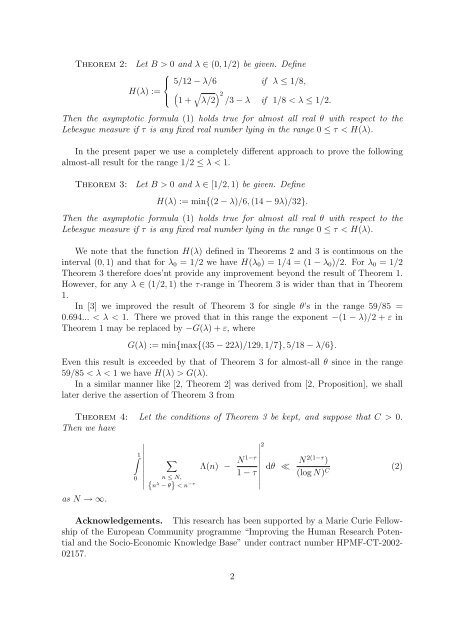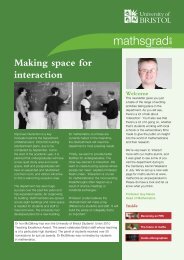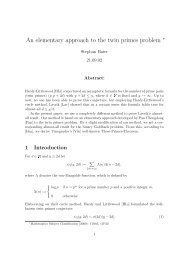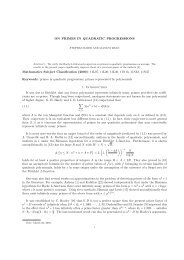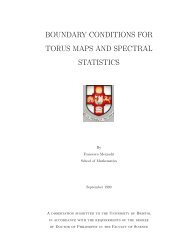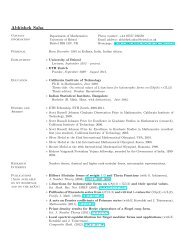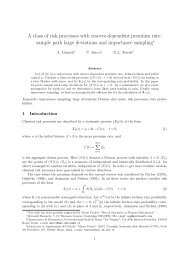Almost-all results on the p^\lambda problem
Almost-all results on the p^\lambda problem
Almost-all results on the p^\lambda problem
You also want an ePaper? Increase the reach of your titles
YUMPU automatically turns print PDFs into web optimized ePapers that Google loves.
Theorem 2: Let B > 0 and λ ∈ (0, 1/2) be given. Define<br />
⎧<br />
⎪⎨ 5/12 − λ/6 if λ ≤ 1/8,<br />
H(λ) := � �<br />
⎪⎩ 1 + λ/2 �2<br />
/3 − λ if 1/8 < λ ≤ 1/2.<br />
Then <strong>the</strong> asymptotic formula (1) holds true for almost <str<strong>on</strong>g>all</str<strong>on</strong>g> real θ with respect to <strong>the</strong><br />
Lebesgue measure if τ is any fixed real number lying in <strong>the</strong> range 0 ≤ τ < H(λ).<br />
In <strong>the</strong> present paper we use a completely different approach to prove <strong>the</strong> following<br />
almost-<str<strong>on</strong>g>all</str<strong>on</strong>g> result for <strong>the</strong> range 1/2 ≤ λ < 1.<br />
Theorem 3: Let B > 0 and λ ∈ [1/2, 1) be given. Define<br />
H(λ) := min{(2 − λ)/6, (14 − 9λ)/32}.<br />
Then <strong>the</strong> asymptotic formula (1) holds true for almost <str<strong>on</strong>g>all</str<strong>on</strong>g> real θ with respect to <strong>the</strong><br />
Lebesgue measure if τ is any fixed real number lying in <strong>the</strong> range 0 ≤ τ < H(λ).<br />
We note that <strong>the</strong> functi<strong>on</strong> H(λ) defined in Theorems 2 and 3 is c<strong>on</strong>tinuous <strong>on</strong> <strong>the</strong><br />
interval (0, 1) and that for λ0 = 1/2 we have H(λ0) = 1/4 = (1 − λ0)/2. For λ0 = 1/2<br />
Theorem 3 <strong>the</strong>refore does’nt provide any improvement bey<strong>on</strong>d <strong>the</strong> result of Theorem 1.<br />
However, for any λ ∈ (1/2, 1) <strong>the</strong> τ-range in Theorem 3 is wider than that in Theorem<br />
1.<br />
In [3] we improved <strong>the</strong> result of Theorem 3 for single θ’s in <strong>the</strong> range 59/85 =<br />
0.694... < λ < 1. There we proved that in this range <strong>the</strong> exp<strong>on</strong>ent −(1 − λ)/2 + ε in<br />
Theorem 1 may be replaced by −G(λ) + ε, where<br />
G(λ) := min{max{(35 − 22λ)/129, 1/7}, 5/18 − λ/6}.<br />
Even this result is exceeded by that of Theorem 3 for almost-<str<strong>on</strong>g>all</str<strong>on</strong>g> θ since in <strong>the</strong> range<br />
59/85 < λ < 1 we have H(λ) > G(λ).<br />
In a similar manner like [2, Theorem 2] was derived from [2, Propositi<strong>on</strong>], we sh<str<strong>on</strong>g>all</str<strong>on</strong>g><br />
later derive <strong>the</strong> asserti<strong>on</strong> of Theorem 3 from<br />
Theorem 4: Let <strong>the</strong> c<strong>on</strong>diti<strong>on</strong>s of Theorem 3 be kept, and suppose that C > 0.<br />
Then we have<br />
as N → ∞.<br />
�1<br />
0<br />
�<br />
�<br />
�<br />
�<br />
�<br />
�<br />
�<br />
�<br />
�<br />
�<br />
�<br />
n ≤ N,<br />
� n λ − θ � < n −τ<br />
Λ(n) −<br />
N 1−τ<br />
1 − τ<br />
�<br />
�2<br />
�<br />
�<br />
�<br />
�<br />
�<br />
�<br />
�<br />
�<br />
dθ ≪ N 2(1−τ )<br />
(log N) C<br />
Acknowledgements. This research has been supported by a Marie Curie Fellowship<br />
of <strong>the</strong> European Community programme “Improving <strong>the</strong> Human Research Potential<br />
and <strong>the</strong> Socio-Ec<strong>on</strong>omic Knowledge Base” under c<strong>on</strong>tract number HPMF-CT-2002-<br />
02157.<br />
2<br />
(2)


